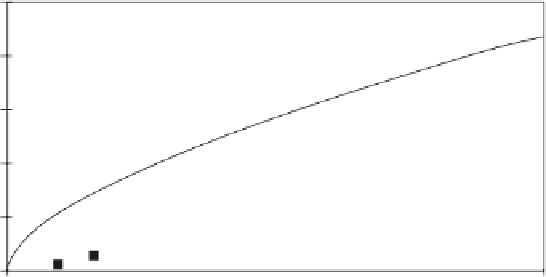Environmental Engineering Reference
In-Depth Information
on several important variables include cold work, Sn content, alloy content
and fabrication history. The lowest temperature dependency is ascribed to
heavily cold-worked Zircaloy-2 and -4, while the highest is for Zr-2.5Nb
CANDU pressure tubes. (It should be noted that the operating temperature
of CANDU pressure tubes is generally below 310°C, 583K.)
Several metallurgical factors infl uence creep. Disturbances in the regular-
ity of the lattice such as those caused by under- or over-sized atoms interfere
with dislocation motion and act as sinks for irradiation-produced vacancies
and SIAs. Of particular importance are the elements disturbing the regular-
ity of the lattice and having appreciable solubility in Zr: Sn, Nb and O, all of
which increase the creep strength (Seibold & Garzarolli, 2002). On the other
hand, an element having low solubility,
S
, has been proposed to increase
the creep strength of Zr-1Nb alloys (Soniak
et al
., 2002; Mardon and Bordy,
2004 ; Rebeyrolle
et al
., 2004). The mechanism is not yet well defi ned, but is
proposed to be a dislocation interaction effect.
Cold working affects three metallurgical parameters: dislocation den-
sity, grain shape and texture (anisotropy), all of which can affect creep rate.
The general observation is that cold worked or cold worked/stress relieved
(CWSRA) zirconium alloys have higher creep rates than RXA alloys. An
example is shown in Fig. 4.69 (Soniak,
et al
., 2002 ). Mechanistic analyses
are, once again, not fi rm on a quantitative effect of dislocation density, but
most, including varieties of the SIPA mechanism, predict higher in-reactor
creep rates with higher dislocation density,
ρ
. Stress relaxation experiments
M4
M5
Zy-4 SRA
Zy-4 RXA
0.025
350°C 90 MPa
0.020
0.015
0.010
0.005
0.000
0E+00
1E+25
2E+25
3E+25
4E+25
5E+25
6E+25
7E+25
8E+25
Fast fluence
φ
t
(n/m
2
)
4.69
Effect of metallurgical condition and alloy composition on
hoop creep strain vs fl uence for SRA and RXA Zircaloy-4 and RXA
M4 and M5. (Source: Reprinted, with permission, from Soniak
et al
.
(2002), copyright ASTM International, 100 Barr Harbor Drive, West
Conshohocken, PA 19428.)

















Search WWH ::

Custom Search